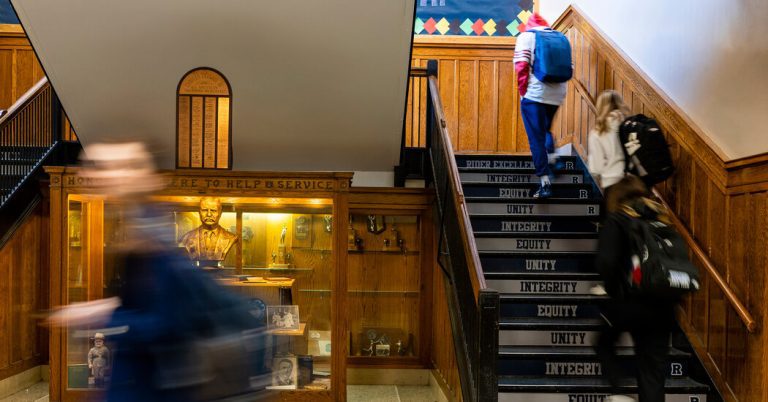Schools across the country have faced no shortage of challenges from the pandemic. Students fall behind academically. There have been cases of misconduct. Students are absent much more often than before.
But there’s another problem that has left some school districts scrambling. Teachers are also missing more school.
Teachers typically receive paid sick days and a small number of personal days. During the 2022-2023 school year in New York, nearly one in five public school teachers were absent 11 days or more, an increase from the previous year and before the pandemic. In Michigan, about 15 percent of teachers were absent each week last school year, compared with about 10 percent in 2019, researchers found.
More recently, teacher walkouts forced a school in Ohio to close for a day and left high school students in Massachusetts huddled in the cafeteria during classes with minimal supervision.
“The proof in the pudding is how many people have used up their leave and are asking to take unpaid time off,” said Jim Fry, the superintendent at College Place, a small neighborhood in southern Washington state. “This was a really rare occurrence. Now it’s weekly.”
Complicating matters is the nationwide shortage of substitute teachers, which many educators say has worsened since the pandemic. Schools serving low-income areas are the least likely to find enough substitutes, research has shown.
Not all districts have seen an increase in teacher absenteeism, but those that do show trends that mirror the broader American workforce.
Workers in many professions are taking more sick days after the pandemic. Women — who make up the vast majority of the education workforce — may also be juggling more childcare, as children stay home from school or daycare more often. (Mothers are 10 times more likely than fathers to take time off work to care for a sick child.)
Employees are also placing more emphasis on mental health. This is particularly important for teachers, who have faced increased demands and political pressure over the past four years, while being paid less than similarly educated professionals and having less flexibility to work remotely.
“The exhaustion is hitting them,” said Ian Roberts, the superintendent in Des Moines, which has recorded about 300 daily teacher absences this year, up from about 250 last year.
Teachers, who take built-in breaks throughout the year and during the summer, have at times faced parental scrutiny for missing school. For example, parents in Newton, Massachusetts, are seeking compensation for a teachers’ strike that led to 11 days of school being out this winter, and teachers’ unions have been criticized for their role in extending school closures during the pandemic. Research shows that a large number of teacher absences can have a negative impact on student learning.
But many teachers say they don’t like missing school, in part because it takes significant work to prepare for and make up for any absences.
“It’s easier to get in, get over it,” said Tracy Bolton, a second-grade teacher in the Houston area who said she reluctantly missed school in November with an extreme case of congestion and fatigue.
When teachers lose their jobs, there are often not enough substitutes available to fill in. In Des Moines, employees can typically find substitutes for just over half of the 300 daily absences.
The shortage of substitutes has increased more since the pandemic, experts say, because fewer people are entering the teaching profession than a decade ago, and there has been more teacher turnover in recent years.
As schools turn to long-term substitutes for unfilled positions, that leaves fewer substitutes available for the days teachers take off, said Tuan Nguyen, an associate professor at Kansas State University who has studied teacher shortages nationwide.
The substitute pool has also changed, educators say.
Some surrogates were reluctant to return after the pandemic closed. others took different jobs and never returned. Substitute pay, which averages about $20 an hour, is less competitive in a strong economy.
When no substitute is available, remaining teachers often have to pull double duty — taking extra students into their class or covering another class on their break — which may lead them to request time off in the future. Sometimes reading teachers or other specialists fill in, meaning extra support sessions — a priority to offset pandemic learning losses — are canceled that day.
“I think this has a huge impact on our ability to recover” from the pandemic, said Amanda von Moos, executive director of Substantial Classrooms, a nonprofit that has sought to improve training and support for substitute teachers.
To ease the daily struggle, the Sacramento school district recently raised the substitute teacher’s salary to $355 a day, or about $54 an hour, one of the highest rates in the nation.
But that didn’t solve another challenge: filling substitute positions in schools that serve some of the lowest-income areas. A study from Chicago found that paying substitutes up to 50 percent more to work in hard-staffed schools can be an effective incentive.
The school district in Columbus, Ohio, has tried something else: assigning at least one permanent substitute to each school building.
Jacquelyn Golden, a full-time substitute teacher at a west Columbus elementary school, has built relationships with students who trust her and give her hugs in the hallway. When substituting, she wastes little time creating class because students know her expectations.
“I’ve been in every room — there’s not a kid in the building who doesn’t know Mrs. Golden,” he said.
The district, however, will soon have to cut the program because it was paid for with expiring pandemic response funding. From now on, permanent deputies will only be available in the buildings with the highest needs.
For Ms. Golden, the bigger question is: Which schools are not in need? Rarely a day goes by, she said, when her services are not required as a substitute.




